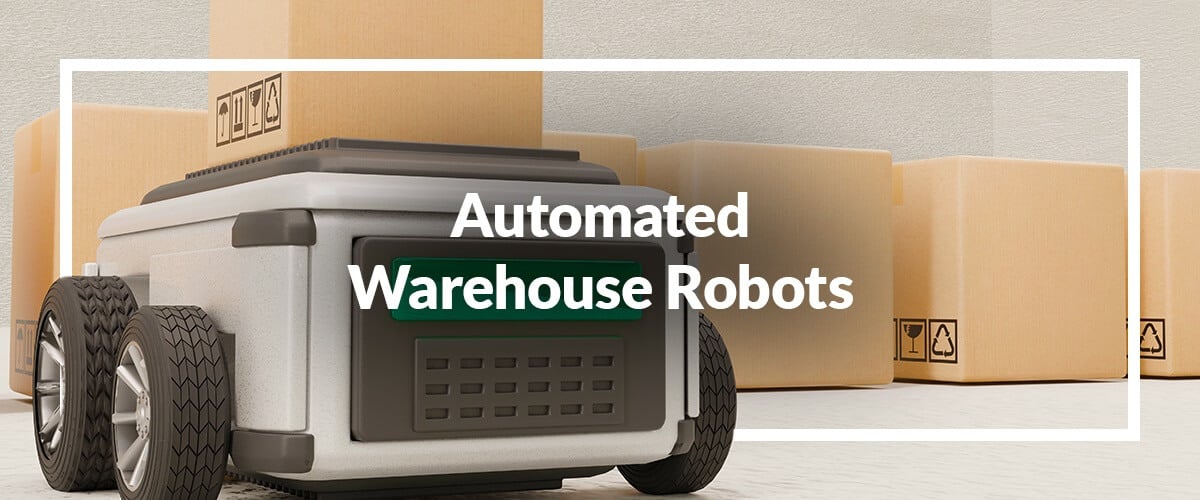Why are automated warehouse robots becoming more popular in modern warehouses? Automating warehouse processes with robots helps reduce reliance on human labor, leading to a more cost-effective, productive, and safe facility. And that’s just a few of the benefits.
Keep reading to fully understand what automated warehouse robots are and how they can optimize your warehouse operations.
But first, here are the key takeaways to know about automated warehouse robots:
- Automated warehouse robots are robotic systems built to complete warehouse tasks with little or no human intervention.
- Several warehouse robot solutions are available, and the right one for your facility will depend on your warehouse processes and goals.
- Some common types of warehouse robots include automated mobile robots (AMRs), goods-to-person (G2P) robots, and drones among others.
- Automated robots can keep your warehouse running 24/7 so you become more productive and profitable.
- A comprehensive warehouse management system (WMS) is essential for making the most of warehouse robots.
Contents
What Are Automated Warehouse Robots?
Automated warehouse robots are robotic systems built to complete warehouse tasks such as picking, packing, sorting, storing, labeling, and more. These systems require little or no human intervention to complete tasks. Instead, they use sensors and cameras to map and navigate warehouse floors and arms to handle goods.
Modern automated warehouse robots work with warehouse management systems (WMS), such as Logiwa. The WMS leverages data from connected systems to assign tasks and program the robots to complete processes automatically. You can also use the WMS to monitor and track the performance and functions of your warehouse robots.
Benefits of Warehouse Robots
Robotics can greatly benefit your warehouse workflows. Warehouse robots have the ability to:
- Reduce costs: You must pay warehouse workers salaries and benefits. Robots, on the other hand, don’t require wages. The cost efficiency of robots makes them an excellent solution for reducing warehouse operating costs.
- Boost efficiency: Warehouse robots are tireless, while human workers get tired and may make mistakes. Studies even show that human error is the leading cause of problems in 46% of warehouses, costing businesses trillions of dollars. With warehouse robots, you can automate repetitive or complicated tasks to reduce errors and improve efficiency and productivity.
- Improve safety: Autonomous mobile robots can handle storing, picking, and packing heavy goods without human intervention. Fewer human workers handling dangerous equipment or heavy items will reduce the risk of costly or deadly accidents within your warehouse.
- Provide real-time data and insights: Automated robots can provide actionable insights for improving warehouse operations. Integrating your robots with a WMS like Logiwa lets you easily view the latest data and insights via a user-friendly dashboard.

8 Common Types of Automated Warehouse Robots
Several types of automated warehouse robots are available. Let’s dive into the most popular types and how they work.
#1. Automated Guided Vehicles (AGVs)
An automated guided vehicle (AGV) is a mobile robot you can program to transport inventory within your warehouse. The robot can operate autonomously by traveling along predefined routes with the help of lasers, optical sensors, or magnets.
AGVs are an excellent alternative to moving inventory with forklifts because the lack of human intervention reduces the risk of accidents.
#2. Automated Mobile Robots (AMRs)
An automated mobile robot travels around a warehouse to retrieve and deliver inventory. Unlike AGVs that can only travel along predefined routes, an AMR can freely navigate around a warehouse. Also, AMRs are more autonomous than AGVs, and you can easily reconfigure them to fit changes in your warehouse layout.
#3. Picking & Packing Robots
Picking and packing robots are robotic arms you can program to retrieve and prepare orders for shipping. Such robots have advanced sensors, grippers, and algorithms for handling and manipulating items of various shapes and sizes to fulfill orders.
You can use picking and packing robots to increase warehouse productivity as they can process orders 24/7 without human intervention. Also, picking robots can pick items at a higher rate than humans, leading to faster and more efficient order fulfillment.
#4. Co-Bots
A warehouse co-bot or collaborative robot is a robotic system that works alongside human workers. Since co-bots must work alongside humans, they have sensors and other features that prevent collisions and accidents with humans.
A co-bot can assist workers in your ecommerce warehouse with picking, heavy lifting, quality control, packing, and shipping. The robot’s accuracy significantly reduces the risk of human error, leading to more accurate order fulfillment.
#5. Palletizing Robots
Palletizing robots are for automating the stacking and organizing of inventory onto pallets. You can use them to bring inventory into your warehouse, organize inventory storage, or retrieve inventory for storage or shipment.
The system’s ability to efficiently and safely stack inventory helps maximize storage space, improve warehouse safety, and reduce the risk of damaged goods.
#6. Automatic Storage & Retrieval System (ASRS) Robots
ASRS robots are robotic systems for automating the storage, retrieval, and handling of warehouse goods. The robot can help optimize warehouse storage space and improve the efficiency of inventory retrieval and placement.
For example, you can program an ASRS robot to store inventory using First-In-First-Out (FIFO) or Last-In-First-Out (LIFO) methods.
#7. Goods-to-Person (G2P) Robots
A G2P robot is any robotic system that can retrieve items from inventory and deliver them to packers for order fulfillment. Such robots minimize human walking time within a warehouse so workers can spend more time on more valuable tasks.
You typically find G2P robots in modern e-commerce fulfillment centers and warehouses with high order volumes.
#8. Drones
Drones are unmanned aerial vehicles used for mapping out and surveilling warehouses. You can also deploy drones to:
- Track items
- Inspect hard-to-reach parts of your facility
- Scan barcodes or RFID tags to update inventory records
- Verify stock levels on high shelves
- Monitor workers and large spaces
Automated Warehouse Robots: Use Cases
Below are specific ways you can use automated warehouse robots to your advantage within your facility.
Pick Path Optimization
Picking paths are the routes your pickers follow to retrieve items from inventory. The larger your warehouse, the more time your workers will spend walking between storage and sorting areas. Also, more walking time means workers spend less of their shift on revenue-generating tasks.
Automated warehouse robots, such as drones and AMRs, can eliminate such issues by mapping out your facility to identify optimal picking paths. These improved picking paths will provide the shortest routes to retrieve inventory for completing orders.
Also, with a WMS like Logiwa, you can access picking path optimization algorithms for minimizing walking path distances and speeding up warehouse operations. Go further by using the WMS to set up your warehouse robots to follow the most effective picking paths for faster inventory retrieval.
Picking & Packing
Warehouses use AMRs, G2P robots, and AGVs to collect and deliver order items to pickers at packing stations. Delivering order items to pickers and packers minimizes workers’ walking time so they can focus on more important tasks, such as processing orders.
Warehouses can also use co-bots and picking and packing robots to aid and speed up packing orders for customer delivery.
Inventory Management
Automatic Storage and Retrieval System (ASRS) robots aid inventory management by automating inventory storage. Such systems use First-In-First-Out (FIFO) or Last-In-First-Out (LIFO) storage methods to store inventory in a highly organized manner.
Efficiently storing inventory maximizes the use of storage space and ensures easy retrieval of items for order fulfillment.
Advanced ASRS robots also offer real-time inventory tracking so you stay updated about stock levels and inventory locations. The real-time inventory insights help prevent overstocking, stockouts, or misplaced inventory.
Product Transportation
Warehouses use palletizing robots to stack products before transporting them for storage or order fulfillment with AGVs or AMRs. Transporting products with automated robots is safer than relying on human labor or heavy machinery, such as forklifts. Conveyor systems are another effective solution for automating product transportation in warehouses.
How to Get Started With Warehouse Robotics
The first step toward automation with robots is selecting a robotics partner that can provide the type of system you need. For instance, leaders in the warehouse robotics industry, such as Locus Robotics, Dematic Robotics, and 6 River Systems, provide various AGVs, AMRs, and picking systems.
Next, you need a warehouse management system that can seamlessly integrate with your robotics system to operate and monitor it.
Fortunately, you don’t have to look far to find a reliable WMS because Logiwa does it all. Our WMS has APIs for integrating with various warehouse systems, including robots from top robotics providers.
Integrating your robots with the WMS will equip you to automate more warehouse processes and optimize cloud order fulfillment within your facility.
Harness the Power of Warehouse Robots With Logiwa
Several warehouse robot solutions are available, and the right one for your facility will depend on your warehouse processes and goals. Regardless of which automated warehouse robot you choose, you’ll need a WMS, and it doesn’t get better than Logiwa WMS.
The WMS integrates fast and seamlessly with all systems from top robotics providers. You can use the WMS to program warehouse robots to complete tasks and track integrated robots to gain real-time insights. Leverage the insights and optimize picking, inventory management, and order fulfillment to become a high-performing warehouse.
To get started with warehouse robotics, request a demo of Logiwa today!
Automate jobs within your fulfillment center – either through robotics, smart batching
Warehouse Management
Modern digital WMS powers a modern fulfillment experience






